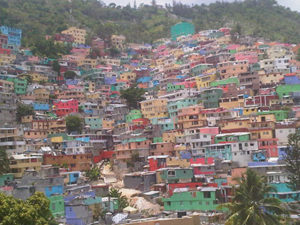 “Jalousie in colors” neglects public safety issues and residents´ needs.
“Jalousie in colors” neglects public safety issues and residents´ needs.
The project “Jalousie en colors,” organized by the government of President Michel Martelly, was started in order to smarten up the hillside slum Jalousie in the district Pétion-Ville of Haitian capital Port-au-Prince.
Rendering homage to Haitian artist Préfète Duffaut, 1,000 houses were painted in bright colors in phase 1 of the project completed in early 2013. The initiative aims at improving the life of Jalousie´s approximately 45,000 inhabitants by beautifying the area and forms part of governmental attempts to relocate people from the camps constructed after the earthquake in January 2010.
“The goal that we are shooting for is a neighborhood that is modest but decent, where residents are proud to be from that area,” said Clement Belizaire, director of the government´s housing relocation program.
The district however faces more severe problems than crumbling facades. According to the recently published seismological study conducted by geologist Claude Prépetit, the hillside slum sits on a secondary fault. Having one of the highest risks of natural disaster Haiti also suffers from frequent flooding and soil erosion due to heavy rainfall.
As houses are often built on steep slopes, residents of Jalousie are in constant danger of losing their homes to mudslides. Prépetit and other experts therefore recommend moving people from the neighbourhood as their safety as well as that of people living in the city below cannot be guaranteed. The slum also lacks a functioning water system and has no electricity supply.
Although in general residents welcome the efforts to improve their neighbourhood they indorse infrastructure improvements such as schools for their children as well as a better access to water rather than decorative repairs. One woman living in Jalousie stressed “what we need are water and electricity,” while another was very content and grateful for the changes. “It´s beautiful. Jalousie is not the same anymore,” she said.
Better view for tourists
Others expressed their disappointment about the government´s actions claiming that the money could have been spent differently. According to the United Nations Children’s Fund (UNICEF), 62 percent of Haitians live below the international poverty line of US$1.25 per day and 350,000 of them still live in camps under worsening conditions while the country is going through a serious cholera epidemic.
Former minister of the Environment Ronald Toussaint who told to the Haitian information service Ayiti Kale Je: “Painting is not the answer.”
Critics of the project also argue that the painting was done in order to provide a better view for guests of two nearby luxury hotels. This is backed by the fact that so far only houses have been painted that face one of the hotels.
“The project to paint Jalousie is nothing more than a social appeasement carried out by the government to satisfy the bourgeoisie who for years has tried to exterminate us, in vain,” concludes resident Sylvestre Telfort to Ayiti Kale Je, an initiative in which alternative media and community radios participate.
In response to scattered protests during a visit to Jalousie in mid August, Prime Minister Laurent Lamothe argued that problems have to be dealt with one at a time. He avoided commenting on the seismological study´s findings and stressed the positive impact the project will have (e.g. the creation of 2,500 new jobs) on the slum. Phase 2 of the project which was launched in August 2013 includes further painting of 3,000 houses in the neighborhood as well as repair works regarding a nearby soccer field. So far residents´ demands for a better water and electricity supply have not been taken into consideration. —Latinamerica Press.
There is no solution to Jalousie.
This was Aristide’s gift to the elite in Petion-Ville.
Now we must live with it.